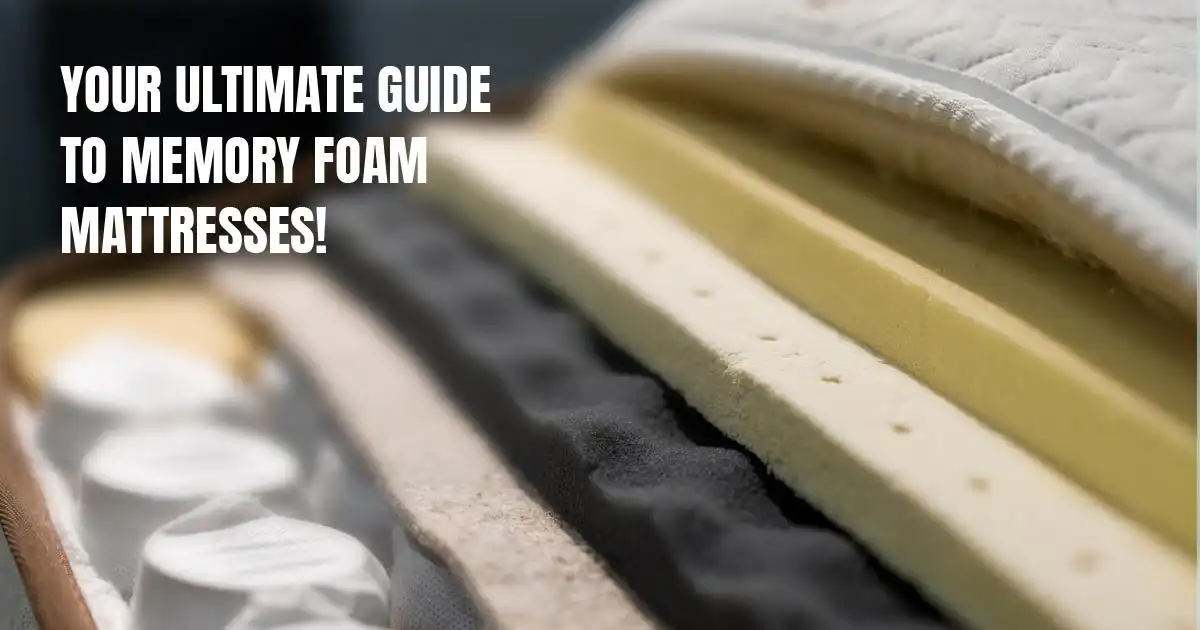Your Ultimate Guide to Memory Foam Mattresses!

Ever heard of the term memory foam?
It’s a material that was initially invented by NASA researchers’ way back in the 1960’s.
Fast forward to 2023, and now it’s all the rage in mattresses!
Well, how does it feel to lay atop a memory foam mattress? Picture yourself sinking into your bed, feeling it hug your body, all warm and cozy. That’s what sleeping on a memory foam mattress is like.
Memory foam mattresses are soft mattresses that hug your shape, making you feel supported. The foams ensure your body weight is spread out evenly keeping your spine in a neutral position. Additionally, these mattresses relieve pressure and soreness from pressure zones of your body like your shoulders, lower back, and hips.
However, memory foam mattresses are not everyone’s cup of tea. Some might find it a tad warm. Others may feel it’s a bit slower to respond when you move compared to other mattresses.
So we, at SmartMattressBuy, are here to discuss all your queries on memory foam – what these mattresses are made of, how they feel, and how to pick the perfect one for your snooze! Join us as we address your questions in our list of top FAQs. We have also shared valuable tips to make the most of your new bedding investment!
Top 30 FAQs – Memory Foam Mattresses
Q1. What Is ‘Memory Foam’?
If you’ve been checking out mattresses lately, you’ve probably come across the term “memory foam.” It’s a type of material that became popular in the mattress industry during the 1990’s. Interestingly it was first made way back in the 1960s for NASA spaceships! They needed something that could absorb shock and relieve pressure.
After that, it started being used in miscellaneous products like helmets, shoes, and even prosthetics. But it wasn’t until the 1990s when a company called Fagerdala World Foams came out with the Tempur Pedic Swedish mattress that memory foam really took off in the mattress world. Since then, it’s been a big hit, especially with those mattress-in-a-box brands!
Q2. What Is A Memory Foam Mattress Made Of?
A memory foam mattress is mainly made from something called polyurethane. It’s a versatile type of plastic that’s used in lots of things like in furniture, insulation, and even in car parts. Now, memory foam mattresses are made of a special type of polyurethane called “viscoelastic” polyurethane foam. This takes a while to change shape when you press on it, and it can bounce back to its original shape soon after.
Different mattress companies have their own secret composition of materials to make the foam just right. But in general, they all use a compound called polyether polyol to give the mattress its stretchy and bouncy qualities.
Q3. What Is It Like To Sleep On A Memory Foam Mattress?
Sleeping on a memory foam mattress is a warm and cozy experience. When you lie down on it, the memory foam gets softer as it warms up from your body heat and molds to your body’s shape. It’s like a cradling sensation and feels relaxing.
But, it’s not suitable for everyone. Some may feel too warm when sleeping on memory foam, while others may feel a bit “stuck” because the foam responds slowly to your movements.
Q4. What Are the Different Types of Memory Foam Mattresses?
Memory foam mattresses come in various styles, each with its own unique features. There are 3 main types:
- Traditional: This is a conventional type of memory foam, known for its ability to contour to your body. However, it can trap heat, potentially making the surface warm.
- Open-Cell: This type has a different internal structure that promotes airflow, helping to disperse heat. Open-cell mattress features improved support and firmness.
- Gel-Infused: Gel is added to the foam, creating pockets similar to open-cell mattresses. It actively absorbs body heat and maintains a cool sleep environment.
Many modern memory foam mattresses combine these three types of foam. Additionally, some incorporate materials like copper for improved cooling and moisture-wicking properties.
Q5. Do Memory Foam Mattresses Have High Elasticity?
In most memory foam mattresses, there’s a type of foam called viscoelastic. It’s made with a compound called polyether polyol, which gives the foam a nice balance of stretchiness (elasticity) and thickness (viscosity). So, when you push down on it, it can bend and flex, but it always goes back to its original shape once you let go. That’s why memory foam mattresses feel so comfortable – they adapt to your body and bounce right back.
Q6. Are Memory Foam Mattresses Too Hot to Sleep on?
Well, it’s a possibility. Memory foam mattresses can trap more heat compared to other types of mattresses. This might be a concern for people who tend to feel warm at night, especially if you live in a hot or humid area.
But don’t worry! Some memory foam mattresses have special cooling features. They can be infused with cooling materials like gel, copper, or graphite to help regulate temperature. Additionally, mattresses with breathable cover allow better airflow, which can help you sleep cooler. So, if you prefer memory foam mattresses there are options available to ensure you stay comfortably cool.
Q7. Are Memory Foam Mattresses Hypoallergenic?
Memory foam is considered hypoallergenic because it’s made of dense foam. This makes it a great choice for people who are prone to allergies from mold, pollen, dust, and even pet dander.
Compared to other types of mattresses, memory foam doesn’t have as many air pockets or gaps between coils where moisture and mold can sneak in. Just ensure to keep your memory foam mattress clean to avoid the buildup of dust and allergens. Give it a good vacuuming now and then, and maybe sprinkle a bit of baking soda, to keep your memory foam mattress cozy and allergy-free.
Q8. How Do I Choose the Right Memory Foam Mattress Suiting My Needs?
It all depends on your sleeping position. If you’re a side sleeper, opt for soft memory foam as it cushions pressure zones like your hips and shoulders and provides pressure relief. For those who prefer sleeping on their stomach or back, medium or firm memory foam will offer the necessary support. So, let your preferred sleeping position be your guide!
Q9. Is a Memory Foam Mattress Suitable For All Sleeping Positions?
Yes, memory foam is a versatile mattress for various sleeping styles. Memory foam contours to your body, providing tailored support. It supports hips and shoulders for side sleepers, offers lumbar support for back sleepers, and keeps stomach sleepers comfortable.
- Side Sleepers:
Soft memory foam is ideal for side sleepers. It effectively reduces inflammation and soreness in pressure points, especially around the hips and shoulders.
- Stomach and Back Sleepers:
For those who prefer sleeping on their stomach or back, medium-firm or firm memory foam offers excellent support to the lumbar region. This keeps your hip elevated and your spine well aligned for better posture.
- Combination Sleepers:
If you switch positions during the night, a ‘medium level’ mattress is the most suitable option as it helps the memory foam to adapt to your changing sleep positions.
Q10. What Type of Memory Foam Mattress is Good for Sleepers with Back Pain?
For those dealing with back pain, a medium-firm memory foam mattress with substantial, adaptable comfort layers is ideal. These layers conform closely to your body, offering a gentle embrace that can alleviate discomfort in the upper and lower back regions. If you weigh less than 130 pounds, a softer mattress may be more comfortable, whereas those weighing more may find a firmer model more suitable.
Q11. Do Memory Foam Mattresses Provide Pressure Relief?
Memory foam mattresses excel at providing pressure relief. They’re crafted to conform to your body’s unique contours, especially around pressure zones like hips and shoulders. This feature has a revolutionary impact in the healthcare industry by improving patient comfort and even preventing bedsores.
The pressure-relieving capability in memory foam is especially advantageous for side sleepers, who often experience pain in their pressure points. So, if you’re seeking personalized comfort and pressure relief, a memory foam mattress can be the ideal choice.
Q12. Are Memory Foam Mattresses Good for Back Sleepers?
Memory foam mattresses are a suitable match for back sleepers specially in the medium to medium-firm range of firmness.
Here’s why. The density and adaptability of memory foam provide a blend of cushioning and support. Back sleepers benefit from memory foam as it cushions the lower section of their body while keeping the pelvis and hips well supported.
Q13. What Is the Best Memory Foam Mattress for Side Sleepers?
For most side sleepers, a softer and more adaptable memory foam mattress, roughly rating around 4 or 5 on firmness, is the way to go. These offer ample cushioning for the shoulders and hips, which greatly improves spinal alignment and eases pressure points.
However, if you’re a side sleeper weighing over 230 pounds, a slightly firmer model (around 6 or 7 on the firmness scale) might be better. This prevents excessive sinking of your body when you lie down, especially in the lower lumbar region. A memory foam mattress is a decent choice for side sleepers, as it provides both pressure relief and support around your hips and shoulders.
Q14. Will A Memory Foam Mattress Be Suitable for Heavier Sleepers (Over 250 Lbs)?
Certainly! However, when considering a memory foam mattress for individuals over 250 lbs, it’s crucial to pay attention to the foam density.
Memory foam mattresses have high core foam densities of 2.2 lb or higher, ensuring ample support for those up to 250 lbs. Memory foam mattresses with lower core foam density of 1.6 lb or 1.8 lb, may develop indentations over time. For individuals over 250 lbs, you should opt for memory foam of 5 lb density or higher to ensure support and durability.
Q15. How Good is a Memory Foam Mattress in Terms of Motion Isolation?
A memory foam mattress fairs well at motion isolation, making it a good choice for light sleepers and couples. This material has a unique ability to absorb motion and prevent it from getting transferred across the bed. A glass of water when placed on a memory foam mattress remains undisturbed on one side while someone jumps on the other side – that’s the magic of memory foam.
Unlike innerspring or latex beds that tend to bounce, memory foam provides stability and minimizes sleep disruptions caused by movement. So, if you or your partner toss and turn or change sleep position frequently, a memory foam mattress can ensure a peaceful night’s sleep for both.
Q16. Is a Memory Foam Mattress Safe for Children?
Generally, memory foam mattresses are considered safe and non-toxic for people of all ages. However, it’s important to note that children may be more sensitive to the chemicals used in the production of most mattresses. If you have concerns about potential allergic reactions, you may want to consider a more natural mattress alternative.
Additionally, look for mattress certifications like CertiPUR-US, OEKO-TEX, and GREENGUARD Gold, which indicate that the bed is free from harmful chemicals. If the mattress you’re considering has these certifications, it is likely safe for use by anyone, including children.
Q17. Do Memory Foam Mattresses Contain Fiberglass?
Not all memory foam mattresses contain fiberglass, but it’s possible to find it in some low-quality or older models, where fiberglass is used as a fire retardant. When shopping for a mattress, it’s crucial to choose one that meets safety standards without compromising your health and safety. Be sure to research and select a mattress that adheres to fire safety regulations while avoiding materials that can pose risks to your well-being.
Q18. How Long Does Memory Foam Mattresses Last? What Is The Expected Life Span?
A memory foam mattress can last from seven to ten years, contingent on maintenance. Proper care, such as keeping it dry and away from heat sources, significantly impacts its durability.
The lifespan of a memory foam mattress can vary depending on factors like usage, care, and the specific materials used. On average, memory foam mattresses can last 10-15 years with proper care and maintenance. The lifespan of this product depends on a couple of factors.
- Density of the foam: Memory foam is classified with a density rating measured in cubic feet, with 1.5 being the lowest and 8 being the highest. In general, the beds that will last the longest and be the most comfortable have densities ranging from at least 3.5 to 5 or 5.3.
- Your size and weight: Heavier people will wear out a mattress faster because of deeper compression. If you’re a heavier sleeper, investing in a firmer bed with dense foams should help you get more use out of the product since it will prevent your weight from sinking into the layers as much.
A low-density foam may last 4-6 years, while high-quality and high-density foam can last 8-10 years. Proper maintenance, such as keeping the mattress dry and away from heat sources, plays a significant role in the durability of your memory foam mattress.
Q19. How Can I Take Care Of a Memory Foam Mattress?
Caring for memory foam requires some special attention.
- First and foremost, to keep memory foam in good condition, it’s crucial to set up the mattress in a dry environment devoid of moisture.
- Memory foam is dense and it can be challenging to dry if it gets wet. Avoid tumble-drying, as it’s not recommended, and air-drying can take a long time. Moreover, air-drying wet memory foam can lead to the growth of bacteria. Liquids can also accelerate memory foam deterioration, so it’s best to keep it dry.
- Furthermore, remember to regularly rotate your memory foam mattress, topper, and pillow. This rotation helps prevent the formation of depressions in areas of concentrated pressure, ensuring even wear and an extended lifespan for your memory foam mattress.
Q20. How Can I Clean Memory Foam Mattresses?
Cleaning a memory foam mattress is a relatively simple task, depending on how frequently you do it.
- Regular maintenance is key to keeping your mattress clean.
- For a deep clean, start by vacuuming it. A handheld vacuum is often easier to maneuver, but a standard-size vacuum will also suffice.
- If you have stains to address, consider using a diluted fabric cleaner, mild detergent, or dishwashing liquid. Create a solution with a 2:1 ratio of water to cleaner and apply it using a spray bottle. Identify the stains and spot-clean them before allowing the mattress to air dry.
Q21. How Long Should You Allow a Memory Foam Mattress to Expand?
On an average, memory foam mattresses may take up to 72 hours to expand fully, especially if they are larger in size. If you have unpacked your mattress, and it has been just a couple of hours, don’t be concerned if the corners seem to be taking their time. Keep in mind that the time of expansion can vary based on the density and thickness of your mattress.
Q22. What Does ‘Density’ Mean in Memory Foam Mattresses?
Density in memory foam mattresses refers to how much the foam material weighs per cubic foot. This is a crucial factor in determining the performance and feel of the foam. Low-density memory foam weighs 3 pounds per cubic square foot or less, offering a softer, more cradling feel. On the other hand, high-density foams, weighing 6 pounds per cubic square foot or more, tend to be firmer, more durable, and capable of handling greater pressure.
While density is important, it’s not the only factor to consider. Firmness and responsiveness to temperature also play vital roles in how a memory foam mattress feels and performs. Additionally, airflow characteristics and temperature sensitivity are other factors worth examining when choosing a memory foam mattress.
Q23. How Thick Are Memory Foam Mattresses?
Memory foam mattresses come in varied thickness options, typically ranging from 6 inches to 14 inches or even more. The right thickness for you depends on your specific preferences and requirements for both support and comfort.
Q24. Can Memory Foam Mattresses Be Flipped?
Generally, memory foam mattresses are not designed to be flipped, as they have a specific orientation for optimal comfort and support. However, you can rotate your mattress time and again, to ensure even pressure distribution, prevent wear and extend their longevity.
Q25. What Type of Foundation is Ideal for Memory Foam Mattresses?
Memory foam mattresses are versatile and can be paired with different foundations, such as platform beds, adjustable bases, and box springs. However, it’s crucial to select a foundation that offers ample support and adheres to the mattress warranty guidelines. Always consult the manufacturer’s recommendations for the best pairing.
Q26. Can Memory Foam Mattresses Be Used with Adjustable Beds?
Yes, a majority of memory foam mattresses are designed to work seamlessly with adjustable beds. Nonetheless, it’s crucial to verify with the manufacturer to confirm that the specific mattress you choose is indeed compatible with an adjustable bed frame.
Q27. How Often Should I Replace My Memory Foam Mattress?
With appropriate care, a memory foam mattress can serve you well for up to 10 years. After a decade, it’s advisable to start considering a replacement. While diligent maintenance can extend its lifespan, expecting more than a decade of use may not be realistic.
Q28. What Are the Downsides of a Memory Foam Mattress?
Some commonly voiced concerns about memory foam mattresses include a feeling of sinking in too deeply, weaker edge support, limited springiness, and the potential for sleeping warm. You can opt for mattresses with firmer constructions, zoned layers, and cooling gel technology to mitigate these concerns.
Q29. How Do I Know If My Memory Foam Mattress Is of Good Quality?
A reliable indicator of quality in a memory foam mattress is a standardized testing certification. This certification guarantees that the mattress is manufactured using approved techniques and materials. In the mattress industry, a certification from CertiPUR-US is a significant mark of quality to seek out.
Q30. How Do I Go About Comparing Memory Foam Mattresses (Both Online and in-store)?
With a range of memory foam mattress options available in the market, it’s essential to have a strategy to make a choice. Start by defining your budget and needs. If you’re looking for an affordable mattress for a few years, there are budget-friendly options on online platforms.
For a longer-lasting, mid-priced option, explore both online and local retailers. Read reviews to gauge customer satisfaction. Visiting a store allows you to test the feel of a memory foam mattress in person, potentially leading you to an ideal match.
Claim the best deals with our Cashback Rebate feature on top mattress brands!
Top 6 Tips to Consider When Shopping for a Memory Foam Mattress!
When it comes to selecting a memory foam mattress, there are a few crucial factors to keep in mind. These considerations play a significant role in determining your comfort and satisfaction with your new bed. Let’s break down the top six tips to consider before making your decision.
1. Tip 1: Contouring and Pressure Relief
For those weighing less than 130 pounds, especially side sleepers, a mattress with contouring and pressure relief features is desirable. However, individuals who sleep on their back or stomach, or weigh more than 130 pounds, should opt for memory foam with light to moderate contouring. Striking the right balance ensures minimal sinkage and reduced pressure in critical areas like shoulders, lower back, and hips.
2. Tip 2: Motion Isolation and Noise
Motion isolation is a key factor to consider when choosing a mattress, especially for co-sleepers. Memory foam mattresses excel in this department, absorbing motion and preventing your movements from disturbing your partner’s sleep. Unlike traditional innerspring or hybrid models, foam mattresses are virtually silent when bearing weight, eliminating any unwanted creaking noises.
3. Tip 3: Temperature Regulation
While memory foam offers exceptional comfort, it tends to retain heat. To address this, some mattresses incorporate cooling materials like gel, copper, or graphite into the foam. Additionally, breathable covers and phase change materials can regulate temperature to ensure a comfortable sleeping surface.
4. Tip 4: Edge Support and Ease of Movement
Memory foam’s slow response to movement and tendency to sink can make changing positions a bit challenging. Additionally, edge support can be a concern, particularly if you like sitting or lying near the edge of the bed. If these factors are top priorities for you, consider exploring other options like innerspring, hybrid, or latex mattresses.
5. Tip 5: Pricing, Trials, and Warranties
Budget considerations are important. Luxury models or those with thicker layers may be on the higher end. Most online purchases come with sleep trials of at least 90 nights, allowing you to test the mattress in your own space. Additionally, a warranty of at least 10 years should cover manufacturing defects. So, choose a mattress after taking these factors in consideration.
6. Tip 6: Online Ordering and Delivery
The convenience of online shopping has made it the go-to option for purchasing memory foam mattresses at great deals. Not only are online options often more affordable, but they also come with the added convenience of doorstep delivery.
Remember, it’s best to have assistance for moving the delivered mattress and setting up the mattress. Once unboxed, allow up to 24 hours for the mattress to fully expand.
Selecting the perfect memory foam mattress involves careful consideration of these essential factors. By keeping contouring, motion isolation, temperature regulation, edge support, pricing, and delivery in mind, you’ll be well on your way to enjoying a restful and rejuvenating night’s sleep!
Smart-Take!
This article is about memory foam mattresses from what they are made of to how they provide exceptional pressure relief. You’ve learned about the various types of memory foam mattresses and which one suits different sleeping positions best. We’ve even discussed factors like motion isolation and temperature regulation, ensuring you get the most out of your mattress.
By keeping these essential tips in mind, you’ll be all set to choose and set up your new memory foam mattress for a truly revitalizing slumber. Always make sure to adhere to the manufacturer’s specific guidelines tailored to your mattress.
If you have more questions about mattresses, read our guide to help understand the basics of mattresses and sleep health.
Explore Smart Deals!
SmartMattressBuy is the pioneer in the mattress industry to introduce the Cashback Rebate initiative. Our platform has a devoted team of mattress experts and analysts, and we ensure 24/7 customer support. We provide transparent sleep health advice, unbiased mattress reviews, price-tracking feature, shopping tips, and exclusive coupons, all in one platform to enhance your mattress shopping experience.









